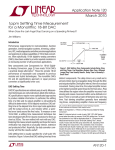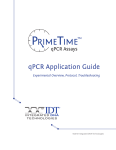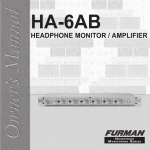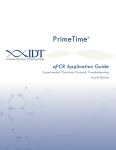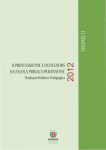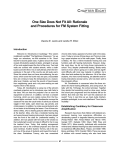Download Troubleshooting finetuning procedures for qPCR system design
Transcript
Journal of Clinical Laboratory Analysis 25 : 389–394 (2011) Troubleshooting Fine-Tuning Procedures for qPCR System Design Alessandro Raso,1 Samantha Mascelli,1 Paolo Nozza,2 Elisabetta Ugolotti,3 Irene Vanni,3 Valeria Capra,1 and Roberto Biassoni,3 1 Neurosurgery Unit, Giannina Gaslini Children’s Research Hospital, Genoa, Italy 2 Pathology Unit, Giannina Gaslini Children’s Research Hospital, Genoa, Italy 3 Molecular Medicine Unit, Giannina Gaslini Children’s Research Hospital, Genoa, Italy Quantitative real-time PCR (qPCR) has been improved and optimized over the past decade for a wide range of applications. Design of primers and probes is one of the crucial steps to obtain high system efficiency of qPCR since design pitfalls influence negatively amplification performances. We report the results of some experiments. First, we demonstrate the utility of optimal primer design and concentration in PCR by constructing suboptimal primers, for instance with hairpin and primer–dimers secondary structures, and quantifying the decrease in efficiency of amplification. Second, we show the adverse effects of the target sequence harboring stable secondary structures on the primer binding sites. Finally, we let see that the mere use of probe-based detection is not enough to ensure robustness of qPCR data, because the eventual detrimental products generated by primers not well designed may influence in any case the PCR efficiency. J. Clin. Lab. Anal. 25:389–394, 2011. r 2011 Wiley Periodicals, Inc. Key words: qPCR; RT-qPCR; primers design; qPCR systems design; SYBR detection INTRODUCTION Quantitative real-time PCR (qPCR) is a sensitive and robust technique directly evolved from the ‘‘end-point detection’’ polymerase chain reaction (PCR) (1). It is able to quantify the levels of specific nucleic acid sequences and detect their copy number changes in the genome. qPCR has been improved and optimized over the past decade for a wide range of applications, such as clinical diagnosis, molecular research, and forensic studies (2). Although the number of its applications is increasing exponentially as the mechanism of PCR itself, there is neither consensus on experiment design nor homogeneity in practice (3). Therefore, in order to achieve reliable experiments and unequivocal interpretation of qPCR data, several practical guidelines have been recently proposed (3–5). Although these guidelines directly focus on most of the practical problems related to qPCR, both consensus on experiment planning and full experimental details in many publications still lack. Such problems emerge clearly in studies conducted with in-house developed assays, for which many researchers fail to provide detailed quality control on the whole qPCR workflow (i.e., nucleic acid extraction, system design or data analysis). c 2011 Wiley Periodicals, Inc. qPCR is based on the quantitative relationship between the amount of target sequence at the beginning and the amount of amplified PCR product at any given cycle combined with the immediate detection of the products. Design of primers and probes is one of the crucial steps to obtain high system efficiency of qPCR since design pitfalls influence negatively amplification performances (6), on which both data analysis and robustness of results rely. In this context, we wish to show the negative effects of these pitfalls on PCR efficiency. Furthermore, in order to achieve reasonable efficiency, some practical suggestions concerning the system design are provided. Thus, we evaluated the performance of SYBR-Green and double-labeled dye oligonucleotide probes comparing their sensitivity, reproducibility, and specificity. The reported method, currently used in our laboratory, allowed us to obtain robust results in Correspondence to: Alessandro Raso, Neurosurgery Unit, Giannina Gaslini Children’s Research Hospital, Largo Gerolamo Gaslini 5, 16147 Genoa, Italy. E-mail: [email protected] and Biassoni Roberto, Molecular Medicine Director, Giannina Gaslini Children’s Research Hospital, Genoa, Italy. E-mail: [email protected] Received 28 April 2011; Accepted 5 August 2011 DOI 10.1002/jcla.20489 Published online in Wiley Online Library (wileyonlinelibrary.com). 390 Raso et al. several fields, such as clinical diagnosis (7,8), neurooncology research (9), and validation of microarray-based studies (10). MATERIAL AND METHOD System Design All primers and double-labeled probes were designed for: b actin (ACTB, NM_001101), Pyruvate kinase (PMK2, NM_002654) and b-2-microglobulin (b2M, NM_004048) using a combination of several utilities such as: Primer Express (PE Applied Biosystem, Foster City, CA), Oligo 4.1 (National Biosciences Inc., Plymouth, MN) and PrimerPy v0.97 (a GUI utility for Q-PCR primer design software). Primers and double-labeled probes are listed in Table 1. Since the product of such software is a redundant list of acceptable primers that do not always satisfy the design requirements (11), we refined appropriate primer/probe sequences following specific criteria. (a) Primer binding sites were selected on separate exon-boundaries to prevent amplification of spurious genomic DNA. (b) Primers and probes were designed avoiding the region-containing SNPs by using the ‘‘www.ensembl.org’’ website. (c) The optimal length of primers was 17–22 bp with no more than 60% G/C content (12). (d) In order to avoid high complementarily primer hybridization that causes nonspecific extension by the DNA polymerase, only primers with no more than three G/Cs within the last five 30 -end nucleotides were selected. (e) The specificity of oligodeoxynucleotides was tested using Primer Blast in order to ensure a single amplicon as product of amplification (www.ncbi.nlm.nih.gov) (13). (f) Internal stability (DG) of primer sequences was chosen with a decrease in 50 –30 sense preventing nonspecific primers hybridization. (g) The difference between Tm of primers (sense and antisense) was kept lesser than 2–31C. Refinement of System Design Following Specific Procedures Fine-tuning procedures to design qPCR systems were achieved by: (i) identifying optimal primer concentrations; (ii) avoiding formation of both primer hairpin and primer–dimmers (PDs); (iii) avoiding primer binding sites on target sequence in region displaying thermodynamically stable secondary structures. To address and show the impact of these features, we forced their presence into the design of primers to obtain biased oligonucleotides that form both hairpin and PDs secondary structures and, primers binding region displaying thermodynamically stable secondary structures. Moreover, we varied the optimal concentration of primers to show its effect on the PCR efficiency. RNA Processing Total RNA was extracted from 5 106 cells of 1603MED line (14) with the use of Trizol reagent (Invitrogen Life Technologies, Milan, Italy), following the standard procedure. Additionally, RNA undergone silica–cartridge purification using the PureLinkTM system (Invitrogen Life Technologies), and total RNA was treated with (RNAse-free) DNAse. RNA was quantified by Nanodrop (Celbio, Milan, Italy) and its quality and integrity was assessed using Agilent 2100 Bioanalyzer (Agilent, Santa Clara, CA). Doublestranded cDNA synthesis was performed using Oligo(dT)20priming by a two-Step cDNA Synthesis kit (Invitrogen Life Technologies). qPCR Condition Amplifications were carried out in 25-ml singleplex runs using EXPRESS SYBR GreenE qPCR or SuperMix-UDG (Invitrogen, Carlsbad, CA) on the ABI PRISM 7500 HT Sequence Detection System (Applied Biosystems, Foster City, CA). Cycling conditions included degradation of preamplified templates for 2 min at 501C, followed by 2 min of denaturation at 951C and then 32 cycles of denaturation at 951C for 20 sec and annealing/extension at 541C for 35 sec, followed by the dissociation stage when SYBR was used. The normalized fluorescent signal (DRn) was TABLE 1. Primers and Probe Designed Gene b2m ACTB PMK2 F R Probe F R Probe F R Probe Primers and probes, 50 –30 sequences Final concentration (nM) TCACAGCCCAAGATAGTTAAG GAGGTTTGAAGATGCCG TGCTGCTTACATGTCTCGATCCC CAACTGGGACGACATGG CTGGGGTGTTGAAGGTC CTGGCACCACACCTTCTACAATGA AGAGAAGGGAAAGAACATCAA GCACCGTCCAATCATCAT CAGCAAAATCGAGAATCATGAGGG 300 300 200 150 300 200 200 100 200 ACTB, b actin; PMK2, pyruvate kinase; b2m, b-2-microglobulin. J. Clin. Lab. Anal. Practical Suggestions on qPCR System Design automatically calculated by the algorithm that normalizes the reporter emission signal. The threshold value applied to get the threshold cycle (Cq) was set at 0.05 in all the experiments. The performances of all designed systems were compared using the Standard Curves (SCs) method. All data were carried out as a mean of triplicate amplifications and repeated at least two times using template from different RNA extraction and cDNA synthesis to evaluate the robustness of the assay. Each qPCR system efficiency (E) was calculated by the equation: E 5 [10[1/slope]1] and experimental design was considered appropriate for relative quantification when the difference of system efficiencies was o0.1 (15). RESULTS Fine-Tuning Procedures We assessed the optimal sequence and concentration of primers (Table 1) that gave rise to a single amplicon for all three systems using SYBR detection as shown by MC analysis (Fig. 1, profiles: A,B,C). The optimized concentration of primers produced comparable efficiency of systems with differences less than 0.1: PMK2 E 5 96%, slope 5 3.42; ATCB E 5 94%, slope 5 13.47, and b2M E 5 94%, slope 5 3.47 (Fig. 1D). We forced the use of inappropriate concentration of primers (i.e., PMK2 amplifications) observing a slight drop in PCR efficiency using both chemical-detection strategies. When the optimal concentration was reduced to 50% (F 5 100 nM, R 5 50 nM), the efficiency of SYBR detection and probe-based detection systems fell 391 by 13% (slope 5 3.83) and 11% (slope 5 3.75), respectively. On the other hand, elevated primer concentrations (F 5 400 nM, R 5 400 nM) delivered efficiencies higher than 100% (characterized by SC slopes less than 3.32) producing nonspecific amplification visible only using MC analysis in SYBR detection (data not shown). The optimal sequence of primers generated Pd structures only with free 30 -ends (i.e., PMK2 sense and antisense primers Fig. 2-1 and 2-2, respectively) and with low thermodynamic stability (DG less that 5 Kcal/ moles). To test the effects of Pds, we specifically designed PMK2-biased primer with unpaired 50 dangling ends (shown in Fig. 2-3). Such inappropriateness produced nonspecific fluorescence signals that were detected by MC analysis using intercalating dye detection (Fig. 3A) with overall efficiencies of 12.4% (Fig. 3C slope 3). The addition of the probe in the same primer system generated similar results: E 5 21.1% (Fig. 3C slope 6). Several artifacts might be caused by the formation of stable hairpin structure of primers, thus to test their effect, we forced the primer design in generating hairpins with either unpaired 50 dangling end or free 30 -end (Fig. 2-4 and 2-5). The use of primer with unpaired 50 dangling end led to a 30% increase in SYBR amplification efficiencies (Fig. 3C slope 1) producing a nonoptimal MC analysis (Fig. 3B). On the other hand, the use of probe detection system (with the same sense and antisense primers) generated 21.1% loss of efficiencies (Fig. 3C slope 5). The use of primer with hairpin free 30 -end structures both by Fig. 1. Optimized primers. MC profiles of: (A) optimized SYBR detection for PMK2, (B) optimized SYBR detection for b2M, and (C) optimized SYBR detection for ACTB. (D) Comparison between SC for the amplification of b2M, PMK2, and ACTB by using SYBR. b2M: R2 5 0.9911; Slope 5 3.47; PMK2: R2 5 0.9905; Slope 5 3.42; ATCB: R2 5 0.9971; Slope 5 3.47. SC, standard curve. J. Clin. Lab. Anal. 392 Raso et al. Fig. 2. Secondary structures of designed PMK2 primers. (1) sense and (2) antisense well-designed primers with low thermodynamic interaction and nonhairpin structures, (3) PD structures of biased primer with and unpaired 50 dangling ends, (4) stable primer hairpin structures with unpaired 50 dangling end and (5) free 30 -end. intercalating dye and probe-based detections generated a decrease in the PCR efficiency: SYBR 5 33% (Fig. 3C slope 4) and Probe 5 22.8% (Fig. 3C slope 7). We also forced the primer design in target region displaying thermodynamically stable secondary structures in the primer binding site to evaluate their effects on PCR efficiency. Such kind of primers led to a loss of PCR efficiencies using both SYBR- and probe-based detection systems (data not shown). Finally, the application of the above-described finetuning procedures allowed us to obtain comparable results in term of reaction efficiency as well as of Cq, using both chemical-detection systems (Fig. 3D). DISCUSSION We present some practical suggestions on system design in order to achieve reasonable system efficiency. Despite these basic criteria have already been proposed elsewhere as guidelines (3–5), an experimental summary with a graphical representation of what may happen, when they are not fulfilled, has not been yet reported. PCR should be considered as a dynamic equilibrium between reactants (primers/probes and target template) and products. The reaction occurs at a defined temperature with (as far as possible) constant saline concentration, taking into account additional parameters, i.e., the optimal working temperature of enzymes, the Tm of J. Clin. Lab. Anal. oligonucleotides and the amount of time required for elongation etc. Given an initial mixture of reactants, the reaction produces a more complex mixture containing specific amplification products simultaneously with a decrease in reactants. Moreover, the reaction is influenced by the formation of secondary folded and dimerized structures of both reactants and products strictly depending on the reaction temperature and the saline concentration. Thus, a balance of all the reaction conditions is required (16). Primer annealing temperature (Ta) depends on its own bases composition and is directly proportional to concentration. All primers used in a quantification experiment have to work at the same temperature (such as reference genes vs target genes). Therefore, once the Ta of the assay is selected, the design of primer sequences should fulfill the assigned assay temperature and thus their final working concentration should to be tested and adjusted accordingly. We tested different primer concentrations to demonstrate the detrimental effects determined by the use of nonoptimal concentration. Our optimal concentration of primers generated a single amplicon as shown by MC analysis using SYBR detection and produced comparable efficiencies between systems, while a decreased concentration of primers (at the same Ta) resulted in a loss of PCR efficiency leading to not comparable SCs. On the other hand, elevate primer concentrations may give rise to fallaciously Practical Suggestions on qPCR System Design Fig. 3. Biased PMK2 primers. MC profiles of: (A) PMK2 with Pds formation and (B) PMK2 with hairpin structure with unpaired 50 dangling end. (C) Comparison between SCs for the amplification of PMK2 by using SYBR Vs Probe. Curve 1: SYBR detection with primers bearing hairpin with unpaired 50 dangling ends; slope 5 2.81, E 5 130%. Curve 2: Optimized SYBR detection; slope 5 3.42, E 5 96%. Curve 3: SYBR detection with Primers yielding PDs; slope 5 3.79, E 5 12.4%. Curve 4: SYBR detection with primers bearing hairpin structures with free 30 -end; slope 5 4.72, E 5 33%. Curve 5: Probe detection with Primers bearing hairpin with unpaired 50 dangling ends; slope 5 4.14, E 5 21.1%. Curve 6: Probe detection with Primers yielding PDs; slope 5 4.12, E 5 21.1%. Curve 7: Probe detection with Primers bearing hairpin structures with free 30 -end; slope 5 4.19, E 5 22.8%. (D) SC of PMK2 using SYBR and Probe detection showing comparable results. SC, standard curve. higher than 100% efficiency. Such detrimental effects are also detectable using probe-based detection systems even if the possible nonspecific amplification products are not detectable by MC analysis. 393 Contrary to the end-point PCR, the qPCR allows the immediate detection of amplified products in any given cycle using a quantitative relationship with the target sequence at the beginning of reaction. Detection is enabled by the generation of a fluorescent signal ensured by two essentially different types of chemical strategies. One is based on doublestranded intercalating dye (SYBR-Green and its evolution) and the other uses dye-labeled probe systems (i.e., exonucleasebased double-labeled dye oligonucleotide, molecular beacons, etc) (6,17). In general, qPCR detection achieved using SYBR-Green is defined as ‘‘nonspecific,’’ whereas detection by fluorescent probes is considered ‘‘template-specific’’ (6,18). Such dichotomy assumes that the use of probe introduces an additional level of specificity since it does not produce any fluorescence signal, due to probe hybridization, for amplicons generated by either mis-priming or PDs. Since primers are always prone to produce duplexes (interacting by itself or others through a few stretch of bases), we consider optimal primers those showing low thermodynamic interaction (DG less that 5 Kcal/ moles). To test the effects of primers with stable PD structures, we forced the design of specifically biased primers. PD formation with unpaired 50 dangling ends is permissive for polymerase extension and it could generate shorter not target-specific amplimers. We showed that optimal primers are only those tending to generate Pd structures with free 30 -ends. Otherwise, the use of a biased primer with unpaired 50 dangling ends would deliver unsatisfactory amplifications either increasing or decreasing efficiency due to the production of nonspecific fluorescence signals. Such inappropriateness becomes obvious by intercalating dye detection allowing the MC analysis, but it is not appreciable using probe-based detection systems, whose deleterious impact on overall efficiency is probably due to primer sequestering that compete with the specific target amplification. In any case, Pds with high thermodynamic stability may have negative effect on PCR efficiency using both chemical-detection strategies. Several artifacts might also be raised by the formation of stable primer hairpin structures; to test them, we forced the primer design in generating hairpin with both unpaired 50 dangling end and free 30 -end. With unpaired 50 dangling end, we observed an increase in amplification efficiencies using SYBR due to higher amount of intercalating dye-labeled product, while probe detection system (using the same sense and antisense primers) generated a loss of efficiencies. This controversy may be explained because 50 dangling end serves as template for nucleotide incorporation starting from the 30 ends giving rise to a spurious hairpin products not detectable by the probe, subtracting reactants from the specific amplification. On the other hand, primers with hairpin free 30 -end J. Clin. Lab. Anal. 394 Raso et al. structures decreased PCR efficiency both by intercalating dye- and probe-based detections. Such detrimental effects may be due to only primers sequestering effect without any possible polymerase extension and it was more evident by SYBR. It is worth remembering that the effects of both Pds and hairpin structures produced inappropriate PCR efficiency, but their nonspecific products are detectable only by MC analysis using intercalating dye chemistry. Otherwise, any dye-labeled probe detection does not allow disclosing such artifacts that we have showed to interfere with amplification efficiency. Secondary structures of target sequence (i.e., loops), displaying high thermodynamic stability at the primer binding site, may also influence the amplification (19). Thus, we checked the folding of the target sequence and their flanking regions using the DNA mfold suite on the M. Zuker website (19), according to the thermodynamic parameters established by J. Santalucia (20). Here we forced the primer design in target region displaying thermodynamically stable secondary structures in the primer binding site to evaluate their effects on PCR efficiency. In general, such kind of primers, hybridizing on loops, lead to a decrease in PCR efficiencies probably due to random reaction imbalance by sequestering effect. In conclusion, the mere use of probe-based detection is not enough to ensure robustness of qPCR data, because the eventual detrimental products generated by nonwelldesigned primers may influence in any case the PCR efficiency. It is highly recommendable to use software packages and web tools to optimize primers and probes design following specific criteria and rules (www.rdml.org). It seems always advisable to validate each probe-based PCR system by using a SYBR-green approach (6). The results herein presented should be seen as an indicative of primer design pitfalls, since dynamic equilibrium of PCR using nonwell-designed primers and template becomes stochastic, largely unpredictable, and finally affect reaction efficiency, quantification, reproducibility, and robustness of data. 2. 3. 4. 5. 6. 7. 8. 9. 10. 11. 12. 13. 14. 15. 16. ACKNOWLEDGMENTS We thank ‘‘Associazione Italiana per la Ricerca sui Tumori Cerebrali del Bambino’’ (www. ARTUCEBA.org) for our research. All authors approve the final version of the submitted manuscript and any revised versions. The authors declare no conflict of interest. 17. 18. 19. REFERENCES 1. Mullis KF, Faloona S, Scharf R, Saiki GH, Erlich H. Specific enzymatic amplification of DNA in vitro: The polymerase J. Clin. Lab. Anal. 20. chain reaction. Cold Spring Harbor Symp Quant Biol 1986;51:263–273. VanGuilder HD, Vrana KE, Freeman WM. Twenty-five years of quantitative PCR for gene expression analysis. Biotechnique 2008;44:619–626. Bustin SA, Benes V, Garson JA, et al. The MIQE guidelines: Minimum information for publication of quantitative real-time PCR experiments. Clin Chem 2009;55:611–622. Raymaekers M, Smets R, Maes B, Cartuyvels R. Checklist for optimization and validation of real-time PCR assays. J Clin Lab Anal 2009;23:145–151. Taylor S, Wakem M, Dijkman G, Alsarraj M, Nguyen M. A practical approach to RT-qPCR-Publishing data that conform to the MIQE guidelines. Methods 2010;50:S1–S5. Bustin SA, Nolan T. Pitfalls of quantitative real-time reversetranscription polymerase chain reaction. Biomol Tech 2004;15:155–166. Di Marco E, Cangemi G, Filippetti M, Melioli G, Biassoni R. Development and clinical validation of a real-time PCR using uni-molecular scorpion-based probe for the detection of Mycoplasma pneumoniae in clinical isolates. New Microbiol 2007;30:415–421. Raso A, Mascelli S, Nozza P, et al. Detection of transplacental melanoma metastasis using quantitative PCR. Diagn Mol Pathol 2010;19:78–82. Raso A, Mascelli S, Biassoni R, et al. High levels of PROM1 (CD133) transcript is a potential predictor of poor prognosis in medulloblastoma. Neuro-Oncology 2011;13:500–508. Mascelli S, Raso A, Nozza P, et al. Specific gene expression signatures of low-grade gliomas (LGG). Oral Commun Neuro-oncol 2010;12:II23–II23. Mann T, Humbert R, Dorschner M, Stamatoyannopoulos J, Noble WS. A thermodynamic approach to PCR primer design. Nucleic Acids Res 2009;37:13. Dutton CM, Paynton C, Sommer SS. General method for amplifying regions of very high G1C content. Nucleic Acids Res 1993;21:2953–2954. Rozen S, Skaletsky HJ. Primer3 on the WWW for general users and for biologist programmers. In: Krawetz S, Misener S. (eds) Bioinformatics Methods and Protocols: Methods in Molecular Biology. Totowa, NJ: Humana Press, 2000. p 365–386. Available from: http://www-genome.wi.mit.edu/genome_software/other/ primer3.html Raso A, Negri F, Gregorio A, et al. Successful isolation and longterm establishment of a cell line with stem cell-like features from an anaplastic medulloblastoma. Neuropathol Appl Neurobiol 2008;34:306–315. Pfaffl MW. A new mathematical model for relative quantification in real-time RT-PCR. Nucleic Acids Res 2001;29:45. Smith WR, Missen RW. Chemical Reaction Equilibrium Analysis: Theory and Algorithms. New York: Wiley; 1982. Ishiguro T, Saitoh J, Yawata H, Yamagishi H, Iwasaki S, Mitoma Y. Homogeneous quantitative assay of hepatitis C virus RNA by polymerase chain reaction in the presence of a fluorescent intercalater. Anal Biochem 1995;229:207–213. Bonnet G, Tyagi S, Libchaber A, Kramer FR. Thermodynamic basis of the enhanced specificity of structured DNA probes. Proc Natl Acad Sci USA 1999;96:6171–6176. Zuker M. Mfold web server for nucleic acid folding and hybridization prediction. Nucleic Acids Res 2003;31:3406–3415. SantaLucia J. A unified view of polymer, dumbbell, and oligonucleotide DNA nearest-neighbor thermodynamics. Proc Natl Acad Sci USA 1998;95:1460–1465.









